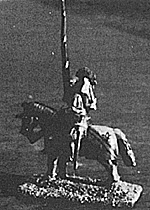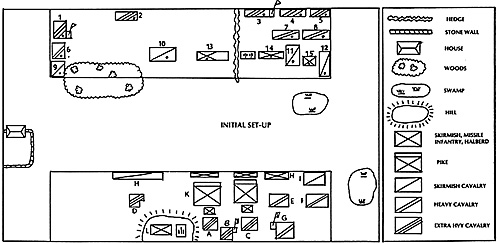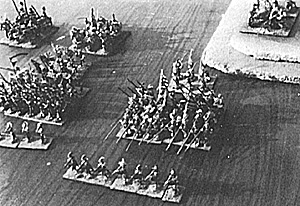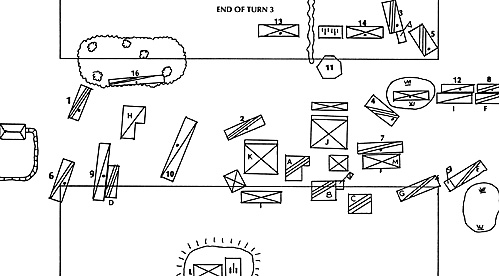 This is a battle report of a large (2200 pt) Renaissance game using WRG 2nd Edition (Renaissance) Rules. It reflected the "clash of cultures" currently developing in the Renaissance gaming field.
This is a battle report of a large (2200 pt) Renaissance game using WRG 2nd Edition (Renaissance) Rules. It reflected the "clash of cultures" currently developing in the Renaissance gaming field.
THE CONSTABLE BOURBON
As the New Orleans based United States Pike and Shot Federation, largely through the efforts of Brian Scherzer, works to bring some organization on a national basis, there have been some reservations about the extent to which local interpretations may lead to conflicts, especially in tournament play. There is no question that these rules reflect Mr. Gush's "brandy and cigars in the War Room" philosophy, and depend to a larger extent on logic and good sportsmanship than the more clearly defined Ancients rules. This game looked to be a good test of such factors, as it brought together Lee Bohn and Dave Friend from the rapidly developing Northern Conspiracy in New England; Bill Howell, New Orleans based and third place finisher in two "national" championships, and myself, meeting all for the first time. I commanded the French, assisted by Dave, while Bill led his Poles with Lee as subcommander.
The French, being outscouted, deployed first. A couple of definitions are in order for those unfamiliar with the period. Napoleonicphiles may be surprised to see that Hussars were the heaviest, most fearsome cavalry available, superior in melee even to their western counterparts, the gendarmes. "Archers" was an archaic term as they no longer carried missile weapons, but were now second line heavy cavalry, slightly superior to their eastern relations, the Pancerni.
Most readers of The Courier should be familiar with the standard armor and morale classes, the possible exception being the intriguing M, or mercenary, class of morale. Such troops maneuver well and fight adequately, but when the going gets tough the Ms get going - home!
The Polish plan was to disrupt our right wing by aggressively employing lighter cavalry, while keeping the Hussars in reserve. Meanwhile, a powerful right wing of 2 Hussar and 3 lighter cavalry units was to collapse our weak left.

The French intended to intercept this latter sweep with two sacrificial units, then use the Lansknechts to block the center against whatever got through. On our right the archers and stradiots were to clear the way of lighter troops, then soften up the Hussars for a decisive final assault by the gendarmes. The Duc de Nemours (Dave), commanding this attack, strongly advised Bayard (c'est moi), that he had more units than he could use in such a confined area, and that another gendarme unit would be more useful on our left. Being a good French commander, Bayard had no time for prudent counsel. One wild card was the French flank march - in these rules heavy cavalry don't count for scouting points, and a hundred points or so would be difficult to estimate in such a large army - so the Poles had little idea what was coming.
As both sides intended a rapid advance on our right, the clash came quickly. The stradiots despatched the cossacks with elan. Stradiots are easily underestimated, being D class open order, but any French general will tell you they fight like demons, presumably smarting from their demotion from B (elite) to D (orders, what orders?) class morale between the Ancient and Renaissance lists.
Toward the center French good fortune continued as the mercenary arquebusiers disordered the Tartars with fire, then drove off their charge. This was a particular surprise as this crew fought under the banner of Orsini - a family much better known for its participation in civil strife than organized warfare. Their most famous scion, Niccolo Orsini, is remembered as the Venetian commander at Agnedello who, upon hearing that his right wing had been engaged by the full weight of a superior French army, marched off with his left saying that his orders were to avoid battle if possible. The Venetians were annihilated, of course, and lost the hard won gains of a century at a single stroke.
 THE FRENCH CENTER: LANDSKNECHTS (R) AND SWISS (L).
THE FRENCH CENTER: LANDSKNECHTS (R) AND SWISS (L).
In the center the Swiss pressed resolutely forward, while the Lansknechts proceeded more cautiously. on the left, the mounted arquebusiers of the Bande Nere galloped gaily out to their doom while the Cossacks rode out to meet them and the Tartars poured into the gap where they had been.
Second Phase
The second phase began as the Polish left wing brought up their middleweights, the Pancerni, who were driven back by the archers on the extreme flank but did manage to break into, then rout, the doughty Orsini. This unit was then knocked off by more archers, allowing the arquebusiers to rally. Serious misfortune befell the French as a crack appeared in the screen that allowed Polish artillery to enfilade the Archers of the Guard, causing 26 casualties including two of Nemours' bodyguard. To make matters worse, this occurred at the end of a turn, allowing two such shots.
Our spirits were lifted, however, when at the same moment the central Hussars were overcome with battle lust and careened madly into the Lansknechts. A closer melee than expected occurred, but the winged warriors were driven off reduced by a third, removing theirthreat (the reader may be assured that this was an uncontrolled advance, rather than some Strangelovesque impulse by the Polish command). While all of this chaos and carnage raged around them, the Swiss of course pressed resolutely onward in the center.
On our left, it was becoming apparent just how much morale had improved since "Ancient" times. The perfectly average Bande Nere, with enemy to front and rear, fired on in flank at point blank range by a unit surprising them from unfriendly cover, with one friend and five enemy in sight, taking six casualties per figure from fire, elected merely to "Do not advance two turns" (good thinkin'!). They were then charged simultaneously in front and rear and, muttering the Italian equivalent of "enough already" (whose direct translation into idiomatic English is thoroughly unprintable), called it a day.
On our extreme left, the gendarmes knocked off the Cossacks and were attacked in turn by Pancerni. This should have been a reasonable contest even though the French were disordered, but they preferred to fight abysmally for two rounds and rout; the only French unit not to earn its stripes. Probably not coincidentally, the leading figure in this group was the legendary (i.e. fictional), luckless, il Castricani, who generally commands his Venetians. He was supposed to pretend he was French for this affair, but apparently wasn't into role playing. Our left wing was gone.
An overview of the situation at about this time demonstrates the value of solid melee infantry. Under these rules infantry are unable to charge cavalry, which is certainly historically correct. Most battles of the period were decided as one side's cavalry routed the other, then the unfortunate side's infantry was forced to stand helplessly immobilized until forced to surrender. The most famous exception, the Swiss charge at Moncontour, was considered quite exceptional, and actually consisted of the infantry charging up to an ongoing cavalry melee, then serving as a rallying point for their horse.
However, even without effective missile support, large units of pike can be far more than expensive spectators by seizing ground and determining the form of the battle. Here the Polish left is being squeezed into a corner, preventing maneuvering and limiting options. The advantages gained are analogous to those of "control of the center" in chess - granting one side space, flexibility, and the initiative. Unfortunately, at the popular 1500 pt tournament size, armies are unable to field both sufficient heavy cavalry and the large infantry units necessary to recreate the combined arms tactics of the 16th Century.
Third Phase
The third phase brought on the crisis on our right as the three Hussar units were committed. Bill's control of the successive waves of attack - lights on Turn 2, Pancerni on 3-4, Hussars on 5-6 was instructive, and if you think that's easy, try it some time. On our extreme right the Hussars broke the stradiots and pursued into the now victorious archers; the second unit pushed back and then routed the already depleted Guard Archers with the bodyguard of the unfortunate Nemours losing 3 then 2 more men, for a total of 9. (if Bayard's bodyguard called him the "chevalier sans peur et sands raproche", Nemours' called him "the widdermaker".) The third Hussar unit, accompanied by the CinC, joined in with the success of their fellows by pushing back a unit of gendarmes. At this time the French flank march finally arrived - ten dispirited and frightened looking French militia crossbowmen. After firing a shot at the fleeing Tartars to keep them going, they were charged by the Cossacks who had previously failed against the Orsini. This time the Cossacks managed to dent the enemy "formation", such as it was.
In the center, the Swiss, etc., etc., getting in position to charge the musketeers, just in time to draw their fire from the decisive cavalry melees.
At this point, time was called, a time limit having been set to simulate tournament condition, allowing extra time for the additional troops. A point count gave a winning draw to the Poles, as the French left was lost while the fighting on the right raged on. This was soon to change, as in the next turn two more French cavalry would break, then the untouched two gendarme units in reserve would lower the boom on the disorganized pursuing Hussars, allowing the French routers to rally while the Poles had committed their last unit. In the center, the massive Swiss pike-halberd unit would have an interesting time against the two musket-halberd units and artillery, but the smart money would probably be on the Swiss. On the left the Poles had 4 1/2 units, who would pursue, rally, then need three turns to cross the board, arriving about Turn 10-11.
It may seem strange to Ancients or Napoleonic gamers used to massive morale failures, but the chance for victory has been lost for both sides; neither the Polish avalanche from their right, nor the French steamroller on theirs having proved decisive. All that remains is what the noted philosopher Al McGuire refers to as "gobbage time", as the remaining units bludgeon away at each other. A draw was the obvious result, and as the Poles currently led in points and were about to improve that situation, they were given the edge.
Post mortem analysis suggested that each of the four commanders made one significant error that could have changed the outcome. The Polish CinC erred in opposing the stradiots with Cossacks, who had little chance, leading to a quick rout and the necessity of committing Hussars to plug the gap. Had Pancerni been used immediately, the French right wing would have had its advance slowed critically. The Polish sub-commander dallied too long against the Bande Nere - eventually committing over 350 pts. to destroy a virtually unarmed 90 pt. unit. Tartars or Cossacks should have laid into this unit on Turn 2, clearing the way for a virtually unopposed advance by heavier troops. The Polish plan would have been completely successful if a couple of heavy cavalry units from their right had swept around past the Lansknechts to engage the French cavalry reserve as the Hussars were breaking through. As it happened, this timing was thrown off by about five turns, enough to allow the French to recover.
The French CinC's conception of the battle was impractical. By sacrificing 200 pts. early, and counting on some far off infantry combat and the eventual commitment of the final reserve to turn the tide, he virtually assured the Poles of an edge whenever a reckoning was made. One possible correction would have been to angle the infantry advance obliquely left, sending the Swiss around the left side of the hedge, and bringing our superior number of cavalry units on the right wing to bear more quickly.
It might appear that it would have been better to send a more powerful flank march to attain the same goal, except that we had to deploy and announce our flank march first, making it quite likely our opponent would deploy his entire force on the other side of the hedge, leaving our flanking force out of play. The French sub-commander conducted his attack aggressively and well, forcing a decision in hissector before his opponent wanted to, but suffered for allowing the Guard Archers to be bombarded. Had this unit attacked their opposing Hussars in full strength they would have had a slight advantage, and even a bounce off would have placed the Polish left in a very difficult situation.
The major point to be derived from this game is that it was smooth, fast paced and exciting, despite the large armies and unfamiliar players. The simple, elegant cavalry combat system, in particular, allows massive mobile actions to be fought with little need for discussion. Many people shy away from Renaissance gaming, feeling that the Ancients rules approach their limit of playability, and the Renaissance, less familiar historically with more obscure troop types and multiple subunits, must be horse. Those willing to try it will be surprised.

Back to Table of Contents -- Courier Vol. VII #5
To Courier List of Issues
To MagWeb Master Magazine List
© Copyright 1987 by The Courier Publishing Company.
This article appears in MagWeb (Magazine Web) on the Internet World Wide Web.
Other military history articles and gaming articles are available at http://www.magweb.com